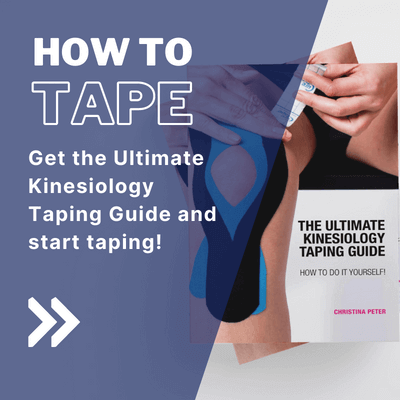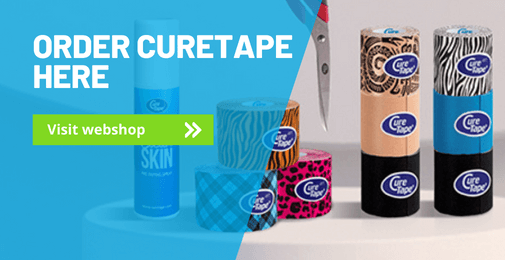Does your knee feel unstable, or do you have pain on the inside or outside of the knee? The following tape application can stabilise the knee, relieve the discomfort and make movement easier. The tapes shown support the outer and inner ligaments of the knee, thereby increasing stability. The tapes can be applied to both sides or just to the inside or outside of the knee.
How to tape inner and outer knee ligament problems
Tips for a good knee taping application
- Is the cause of the complaint or pain clear?
- Check if there any contraindications for not taping.
- Before you start taping, carefully read the instructions.
- Choose a colour of tape, any colour that fits your mood!
- Round of all the edges to prevent peeling.
- Do not stretch the tape at the beginning and the end.
- Rub the tape well for adhesion. Heat activates the adhesive layer.
- Showering or swimming is possible, pat the tape dry after it gets wet. Do not rub it hard.
- It is easier to remove the tape with body or massage oil.

Christina’s advice when taping your knee
In the self-taping instructions, I have chosen taping applications that are easy to apply yourself. In order to make this treatment safe, I give practical tips, which you should take into account before, during and after a tape treatment. They are based on my years of practical experience. If the complaints persist, always consult a therapist or doctor.
Preparation for taping knee ligaments
Tape
Shape: I-Tapes.
Number of strips: 3.
Technique: Ligament technique (maximum/full stretch).
Measuring and cutting the tape
Stap 1:
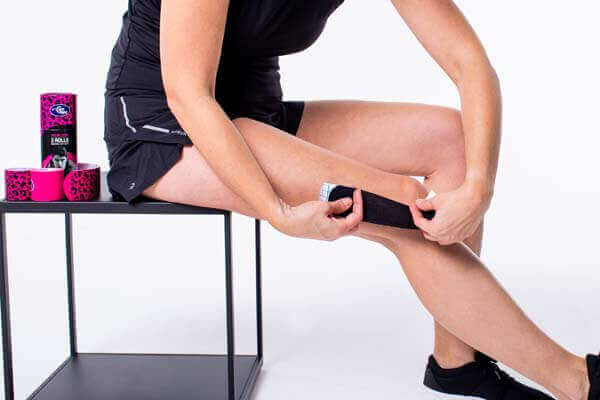
Stap 2:

- Sit in a position where you can easily reach the inside and outside of the knee.
- Measure the required tape length of the three tapes. They must be parallel to the outside and inside of the knee.
- Cut the tapes about 5 cm shorter, as the full stretch on the tapes will make them several centimetres longer.
Applying the tape
Step 1:

Step 2:

Step 3:

Apply tape: outer knee ligament
- Bring the knee into a straight position and turn the foot slightly inwards.
- Tear the release paper from the tape in half, fold the paper away on both sides, and apply the middle part to the outside of the knee under full tension.
- Position the two anchors without tension and rub the tape firmly into place.
Apply tape: inner knee ligament
- Bend the knee slightly and turn the foot outward.
- Place the middle part of the tape on the inside of the knee with a full stretch, then place the two anchors without a stretch.
- Attach the tape and rub it well.
- Now place the second tape slightly crosswise over the first tape using the same application technique and rub it well.
The knee should immediately feel more stable. If this is not sufficient, you can also additionally apply the tape application for stabilisation of the knee or kneecap.
Popular products to tape your foot
-
MYCureTape® – 3 Rolls Kinesiology Tape – Value Pack
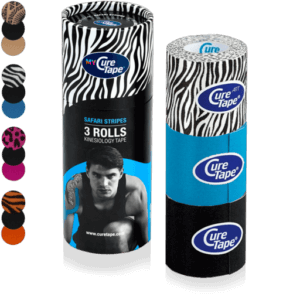 $26.95
In stockSelect options This product has multiple variants. The options may be chosen on the product page
$26.95
In stockSelect options This product has multiple variants. The options may be chosen on the product page -
Book: The Ultimate Kinesiology Taping Guide
 $29.95
In stockAdd to cart
$29.95
In stockAdd to cart -
CureTape® Ultimate Self-Tape Starter Kit
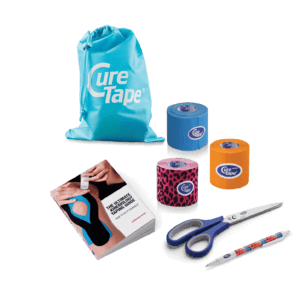 $87.95
In stockAdd to cart
$87.95
In stockAdd to cart
Learn how to tape
- 30 taping instructions for common injuries that taping can help you with
- 176 pages of clear written instructions
- 200 step-by-step instructions accompanied by photo’s, illustrations and scannable video’s through QR codes
What are you waiting for? Order your copy today!
*This book is intended for people who want to tape an injury or complaint themselves. If uncertain about the complaint, consult a physiotherapist.
THYSOL is the manufacturer of the kinesiology tape brand CureTape. As CureTape, we have been training and supplying professionals for almost 25 years. And consumers now know how to find us too! By manufacturing all our tapes in our own factory, we can guarantee the best quality!
Please note that the indicated tape applications and information on our website about the possibilities with kinesiology tape have not yet been scientifically proven. The statements and examples mentioned are based on long-term experiences of patients and trained therapists.
Contraindications not to tape: pregnancy, open wounds, broken bones, unexplained complaints, allergies and skin diseases, use of medication such as blood thinners, thrombosis and fever. Always apply tape in consultation with a specialist.


